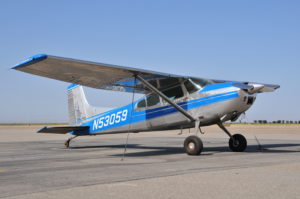The 180 is a lot of fun and a good hauler for those who love the off airport experience. Cessna ads proclaimed 1953 as the “Golden Year of Flying” (50 years since the Wright brothers made their first flight). Amidst all the fanfare, a new model was proudly introduced, called the 180.
Basically a beefed-up 170 with 80 more horses, it was an exciting new airplane from the nose’s new spinner to the new square tail. The 180 was originally heralded by Cessna’s marketing folks as “the businessman’s airplane,” but the airplane quickly gained a reputation for solid dependability and utility in the back country. Over the years, Cessna built 6,193 of them.
Production of the 180 began in 1953 and lasted until 1981. With a square tail, paralift flaps, spring steel landing gear, steerable tailwheel, and all-metal construction, Cessna 180 airplanes all look the same from the outside. The most significant changes over the years were in gross weight and engine. Gross weight increased from 2,550 pounds to 2,800 pounds, and the original Continental O-470-A 225-hp engine was upgraded over time to the Continental O-470-R 230 hp. The 1952 prototype was a modified 170B, with a new engine, a rectangular fin with a dorsal fairing, and reshaped side windows. Other changes include improvements to the steering, cowling, optional wheel fairings, and new wing tip design. Over the years, models A through K were produced, totaling 6,192 Cessna 180s. A complete detailed history is found in Edward Phillips’ book Wings of Cessna.
Pilot uniformly report good handling of the 180 in the air, but on the ground, they sing a different tune. Visibility during taxi calls for S-turns, which is expected in a tailwheel. Ground loop avoidance, particularly in gusty conditions, calls for the utmost attention and tap dancing on the rudder pedals. 42% of all Cessna 180 accidents are due to ground loops during takeoff or landing.
Buz Landry, president of the International 180/185 Club, a group of 1,480 owners in 23 countries (you have to own one of the two types to join), calls the 180 “the most versatile aircraft ever designed. It flies fairly quickly, carries a good load, and can operate out of most rough and short strips.”
In Alaska, where livelihoods and lives depend on airplanes, the 180’s reliability and utility made it about as common as long winters. On wheels, floats, or skis, there are more Model 180s in Alaska than in any other state. “You always make it back in a 180,” says Bud Morrison, of Woodland, Washington, who figures he has 10,000 hours in 180s and 185s. “It’s got manual flaps, a simple carburetor — not fuel injection — and no fussy electronics or systems to break down in the boonies.”
The 180 isn’t perfect. Without soundproofing, the 180 is a bit noisy. There are airplanes that will fly faster, others that will haul more, and a few that will get in and out of shorter runways. But the 180 does all these things pretty well. Airplanes that do several things well, the “jacks of all trades,” endear themselves to people who use them for recreation and business.
The airframe of the 180 is all metal, constructed of aluminum alloy. The fuselage is a semi-monocoque structure, with exterior skin sheets riveted to formers and longerons. The strut-braced wings, likewise, are constructed of exterior skin sheets riveted to spars and ribs. The landing gear of the 180 is in a conventional arrangement, with main gear legs made of spring steel, and a steerable tailwheel mounted on a hollow tapered steel tube.
The Continental O-470-A of 225 horsepower (168 kW) was installed in the 1953 model, which uniquely has no baggage door. The Continental O-470-J, also of 225 horsepower (168 kW), replaced the -A model in 1954 and 1955, and was succeeded by the 230 horsepower (170 kW) O-470-K from 1956 through 1961, by the O-470-R from 1962 through 1972, by the O-470-S from 1973 through 1976, and by the O-470-U from 1977 through the end of production.
Cessna 180s produced between 1953 and 1963 have two side windows, while 1964 to 1981 models feature three side windows, as they feature the same fuselage as the Cessna 185. Some late production 1962 Cessna 180s were also known to have the three windows as well.
The 180 also known as the Skywagon is the prefered family hauler for bush type off airport flying. With a good cruise speed and range the demand for a 180 has meant the aircraft holds its value.
